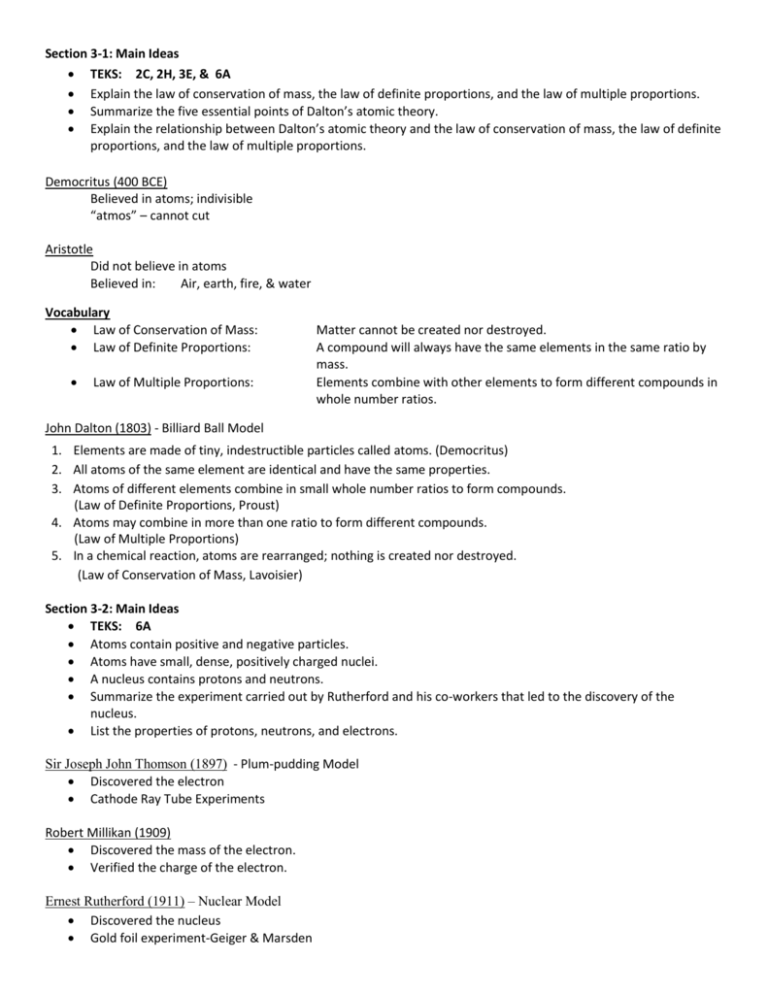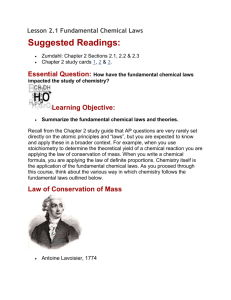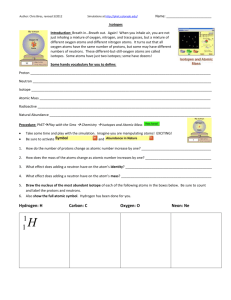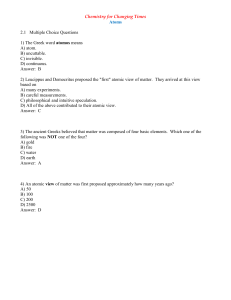Section 3-1: Main Ideas TEKS: 2C, 2H, 3E, & 6A Explain the law of
advertisement

Section 3-1: Main Ideas TEKS: 2C, 2H, 3E, & 6A Explain the law of conservation of mass, the law of definite proportions, and the law of multiple proportions. Summarize the five essential points of Dalton’s atomic theory. Explain the relationship between Dalton’s atomic theory and the law of conservation of mass, the law of definite proportions, and the law of multiple proportions. Democritus (400 BCE) Believed in atoms; indivisible “atmos” – cannot cut Aristotle Did not believe in atoms Believed in: Air, earth, fire, & water Vocabulary Law of Conservation of Mass: Law of Definite Proportions: Law of Multiple Proportions: Matter cannot be created nor destroyed. A compound will always have the same elements in the same ratio by mass. Elements combine with other elements to form different compounds in whole number ratios. John Dalton (1803) - Billiard Ball Model 1. Elements are made of tiny, indestructible particles called atoms. (Democritus) 2. All atoms of the same element are identical and have the same properties. 3. Atoms of different elements combine in small whole number ratios to form compounds. (Law of Definite Proportions, Proust) 4. Atoms may combine in more than one ratio to form different compounds. (Law of Multiple Proportions) 5. In a chemical reaction, atoms are rearranged; nothing is created nor destroyed. (Law of Conservation of Mass, Lavoisier) Section 3-2: Main Ideas TEKS: 6A Atoms contain positive and negative particles. Atoms have small, dense, positively charged nuclei. A nucleus contains protons and neutrons. Summarize the experiment carried out by Rutherford and his co-workers that led to the discovery of the nucleus. List the properties of protons, neutrons, and electrons. Sir Joseph John Thomson (1897) - Plum-pudding Model Discovered the electron Cathode Ray Tube Experiments Robert Millikan (1909) Discovered the mass of the electron. Verified the charge of the electron. Ernest Rutherford (1911) – Nuclear Model Discovered the nucleus Gold foil experiment-Geiger & Marsden Niels Bohr(1913) – Planetary Model Electrons in orbits Ernest Rutherford (1919) Discovered the Proton. James Chadwick (1922) Discovered the neutron Vocabulary Atom Nuclear forces Section 3-3: Main Ideas TEKS: 6D, 8A & 8B Explain what ions are. Explain what isotopes are. Define atomic number and mass number, and describe how they apply to isotopes. Given the identity of a nuclide, determine its number of protons, neutrons, and electrons. Define mole in terms of Avogadro’s number, and define molar mass. Be able to calculate molar mass of an element/compound. Solve problems involving mass in grams, amount in moles, and number of atoms of an element. Perform conversion between Moles Mass and Moles Particles. Vocabulary Atomic Number (Z) Atomic Mass Number (A) Ions Isotopes Nuclides AMU Relative Atomic Mass Average Atomic Mass Mole Avogadro’s Number Protons Positive particle found in nucleus Mass of 1 Electrons Negative particle found in electron cloud Mass of 1/1836 Neutrons Neutral particle found in nucleus Mass of 1 Atomic Symbol Notation 𝐴 𝑍𝑋 “A” Atomic Mass Number “Z” Atomic Number Hyphen Notation Element Name-Atomic Mass Number (A) ex. Oxygen-16









